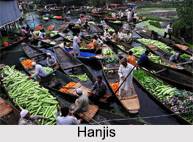 Hanjis of Kashmir are the traditional boatmen who are an important ethnic group in the Valley of Kashmir. They are mainly restrained to the Dal, Wular, Anchar and Manasbal lakes and the Jhelum River particularly between the Khanabal District and Chattabal, Srinagar.
Hanjis of Kashmir are the traditional boatmen who are an important ethnic group in the Valley of Kashmir. They are mainly restrained to the Dal, Wular, Anchar and Manasbal lakes and the Jhelum River particularly between the Khanabal District and Chattabal, Srinagar.
History of Hanjis
It is believed that Raja Parbat Sen introduced the boatmen in Kashmir from Sangaldip. Some of them believe that they are the descendants of Hazart Noah. Though there is no unanimity among the scholars regarding their arrival in the valley of Kashmir, The Hanjis are believed to have descended from an ancient racial group, essentially the Nishads. Even the Rajatarangini often mentions the Nishads (boatmen) and boat bridges. However, it is generally held that they were Kshatriyas before their conversion to Islam. Nishads find mention in Vedas, Manusmriti, Mahabharata, Kalhana"s Rajatarangini etc. Some Historians said that Nishadas were also fighting for Kauravas as well as for Pandavas in the Mahabharata war. Some Historians said that Valmiki"s Ramayana also mentions of Nishadas. Shabri, an elderly woman who met lord Rama in a forest belonged to Nishada tribe. Nishadas living in Kashmir converted to Islam in early fourteenth century and most of them started adopting kashmirian nicknames as their castes.
Another group of historians said that this tribe in fact lived on the banks of river Saraswati and were engaged in ferrying people across the rivers, apart from collecting wood and fuels from the forest. When the river dried, they too moved to different parts of the country for their livelihood.
Groups of Hanjis
The major sub-groups of Hanjis are:
•Demb-Hanz (vegetable growers)
•Gari-Hanz (water nut gatherer/s)
•Gad-Hanz (fisherman)
•Mata-Hanz (who deals in wood)
•Dunga- Hanz (owner of passenger boats)
•Haka-Hanz (gatherers of wood from water bodies)
•Bahatchi-Hanz (who live in Bahatch boats), Shikare Hanj (who ply shikara boats)
•Houseboat-Hanz
Demb-Hanz sect lives in or close to lakes and canals and engaged in growing vegetables. Gari-Hanz lives in lakes in boats and was engaged in collection of water chestnuts from lakes. Gad-Hanz is the fishermen sect who simply collects the fish from lakes, rivers and canals. Mata-Hanz sect sells wood and firewood. They live near riverbanks to sell firewood and timber to people. Dunga- Hanz owns Doongas which they rented out to people for picnics and other social get together. Haka-Hanz sect brings wooden scraps from rivers in boats and sells them to people as winter fuel. Bahatchi-Hanz presently engaged in digging sand from river beds in Kashmir.
Lifestyle of Hanjis
The different types of Han¬jis use boats of different shapes and sizes. The type of boat which a Hanji used denotes his caste, social status and profession. They are mainly reliant on tourism, vegetable farming, fisheries and water transportation. Economically, the Hanjis are backward. The Gad-Hanj and the Demb-Hanj are maintaining a poor standard of living.



















